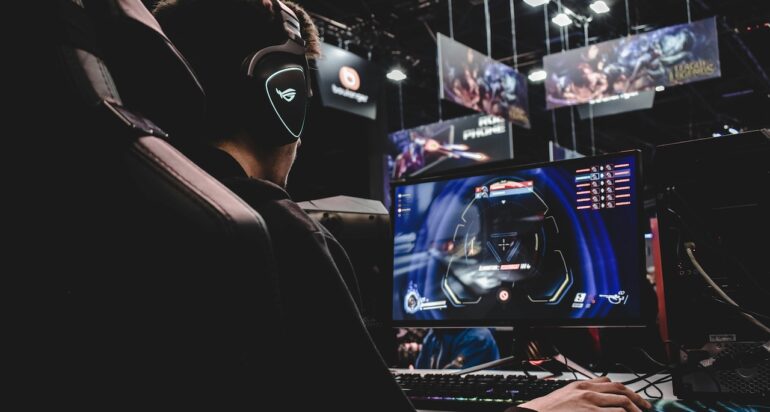The world of competitive video gaming, known as e-sports, has exploded in popularity and profitability over the last decade. Once viewed as a niche hobby, e-sports is now a multi-billion dollar industry, with top players and teams attracting huge audiences and sponsorship deals. This essay will examine the major factors that have contributed to e-sports’ monumental growth.

Table of Contents
Defining E-sports
Simply put, e-sports involves professional video game players competing against each other in popular multiplayer games. Some of the most common e-sports games are:
- League of Legends
- Dota 2
- Counter-Strike: Global Offensive
- Overwatch
- Call of Duty
- FIFA Soccer
These players face off in professionally organized tournaments and leagues in front of live audiences and streaming viewers. The scale and production value rivals traditional sports.

Growth Factors
Several key factors have facilitated the e-sports explosion:
Technological Advances
- Fast internet enables smooth online gaming and streaming
- Powerful gaming PCs and consoles allow for immersive, high-quality experiences
- Game developers utilize new technologies for compelling gameplay and graphics
Mainstream Accessibility
- Video games are more popular and acceptable than ever
- Streaming platforms like Twitch and YouTube Gaming give global reach
| Year | Global E-sports Audience | Revenue |
|---|---|---|
| 2017 | 335 million | $696 million |
| 2022 | 532 million | $1.38 billion |
Celebrity Culture
- Top e-sports celebrities sign lucrative sponsorships
- Some players earn over $5 million per year
- Teams partner with traditional sports franchises for greater reach
As you can see in the above table, e-sports has seen tremendous growth in audience and revenue over a short five year span. Let’s examine the components driving this boom.
The Rise of Game Streaming
Game streaming services have connected e-sports to more fans globally than ever before.
“Without streaming platforms, you wouldn’t have an audience and the whole e-sports industry wouldn’t exist as it does today.” – Carlos Rodriguez, Former Captain of G2 Esports
Platforms like Twitch and YouTube Gaming give people free access to all major competitive gaming content. Fans can easily watch tournaments, follow top competitors, or view exclusive player interviews. This level of immersion was impossible in e-sports’ early days. Broadcasting matches on streams instead of niche gaming channels proved pivotal.
Importantly, streaming opened e-sports viewership to casual audiences beyond avid gamers. Interested viewers can tune into intense matches without buying expensive gaming equipment or game licenses. They watch online through websites and apps via any device. This mainstream accessibility converts more people into fans and grows media value. Sponsors take notice too.
In terms of numerical impact, market researchers Newzoo found that 182 million e-sports viewers specifically used streaming to follow competitions in 2022. They expect over 347 million stream-based viewers by 2024. The simplicity of opening a browser or app to instantly view events will continually expand exposure.
Million Dollar Events & Sponsorships
The most prestigious e-sports tournaments now offer massive cash prizes and attract blue chip corporate sponsorships. For example:
- The 2022 League of Legends World Championship had over $2.2 million awarded
- The annual Dota 2 tournament The International has a prize pool exceeding $40 million
- Red Bull, Mercedes Benz, and Mastercard sponsor major annual competitions
These big money sponsorships stem from huge audience demand. Analysis shows that across major streaming platforms, viewers consumed over 9 billion hours of e-sports content in 2021 alone. This represents incredible promotional value for brands that sponsor events or advertise through them.
As viewership swells from greater streaming accessibility, so does event sponsorship appeal. This is clearly evidenced by Mercedes Benz deciding to end its traditional tennis sponsorship to exclusively back an e-sports league. More big brands will follow as profits boom.
While many e-sports tournaments originally had small prizes or were community funded, corporate money now fuels rapidly rising reward pools. This draws more competitive players from across the world. In turn, higher skill levels make matches more exciting and further build viewership. This cycle will perpetuate as investment accelerates.
Celebrity Competitor Earnings
In tandem with bigger tournaments and sponsorships, top e-sports athletes now have celebrity status and earnings on par with traditional sports stars. Through various revenue sources, famous players can make over $5 million annually:
Team Salaries
- Leading esports athletes sign multi-million dollar contracts with major teams and franchises
- For comparison, NBA and European soccer stars make around $7 million per year
Tournament Winnings
- Big event prize pools mean huge payouts for victors
- The 2021 Dota 2 winning team took home $18 million to split
Branded Sponsorships & Endorsements
- Personality players build their own brands and partner with labels
- Popular streamers often earn over $50k monthly from sponsor deals
This financial success draws more competition for coveted player spots on major teams. Top performers become heroes to aspiring gamers worldwide. Their fame perpetuates gaming’s popularity and fuels more interest in e-sports. Ultimately, star power advances viewership and revenue.
Mainstream Mass Media Coverage
As you can see, competitive gaming has clearly entered the big leagues, as evidenced by soaring viewership metrics and profits. Accordingly, e-sports now receives increased coverage from traditional mass media alongside gaming channels.
ESPN and other sports networks broadcast and analyze major tournaments similar to traditional sporting events. E-sports athletes appear on talk shows and news broadcasts. Even television dramas and comedies feature gaming plot elements. This normalized, positive mass media exposure helps further e-sports’ credibility and recognition.
Additionally, nearly every major print publication from Time Magazine to the New York Times closely follows e-sports developments, team transactions, and player profiles. As competitive gaming penetrates deeper into mainstream culture, the media attention and perceived legitimacy builds in a reciprocal feedback loop.
Global Appeal
Importantly, the e-sports phenomenon stretches across the world, as streaming enables universal access. Fans follow leagues featuring elite teams from North America, China, Europe, South Korea, and beyond. Events sell out massive arenas from Los Angeles to Jakarta.
These international superstars inspire gaming passion across many cultures. Consider Brazilian soccer legend Neymar partners with and plays for an e-sports organization. This shows how competitive gaming permeates all levels of mainstream sports and entertainment. That global accessibility and resulting diverse talent fuels tremendous growth.
Conclusion
In summary, e-sports represents one of the fastest rising professional industries thanks to several key trends:
- Game streaming opening viewership
- Soaring tournament investment and sponsorship
- Millionaire celebrity competitors
- Mass media validation
- Universal mainstream enthusiasm
As these factors compound and accelerate, the popularity and business prowess of competitive gaming will continue climbing. While still nascent compared to traditional sports, e-sports possesses immense momentum and potential. The next decade promises to take professional video gaming even more mainstream.

